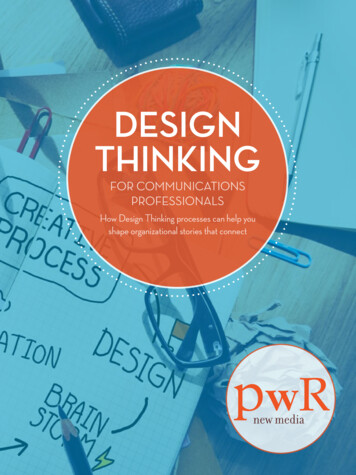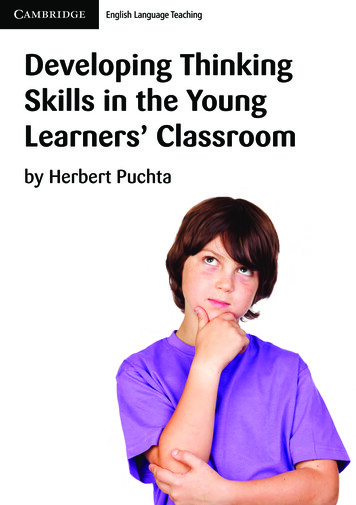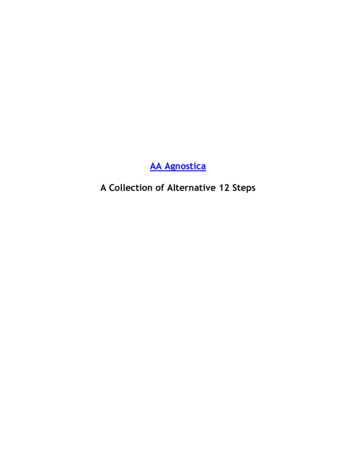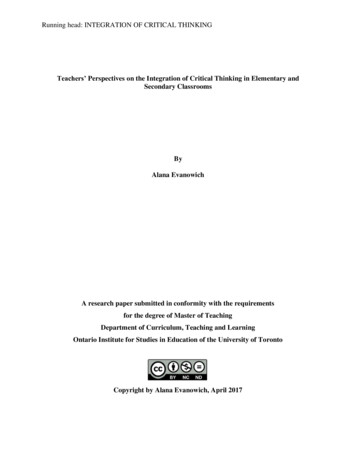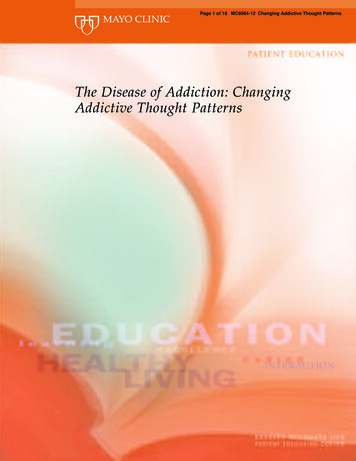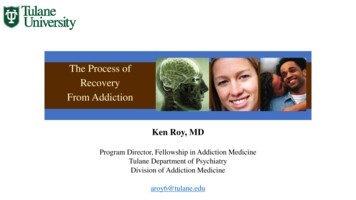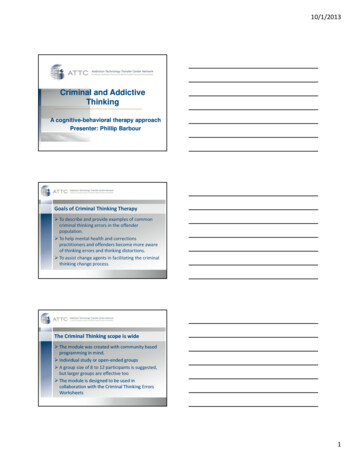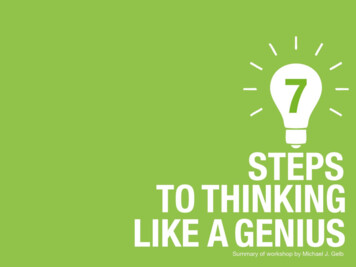
Transcription
OverviewIn our complex world, thinkingcreatively is an essential skillfor all of us as we seek toreach our full potential. What ifyou could call on history’sgreatest genius, Leonardo daVinci, to be your personalmentor in cultivating thisability? This is the questionMichael J Gelb, pioneeringcreative thinker, explored inhis workshop at the 2012 Mind& Its Potential conference.7 STEPS TO THINKING LIKE A GENIUSLeonardo was theembodiment of the creativespirit and his approach tooptimising human potential isnow more relevant than ever.Every child is born with the genius potential of a Leonard daVinci – unfortunately, we often go about “de-geniusing” them.Michael J. Gelb has crystalised da Vinci’s creative thinking inhis international best-seller How to Think Like Leonardo DaVinci: Seven Steps to Genius Every Day into seven principles:Anatomist, architect, botanist,city planner, chef, humorist,engineer, equestrian, inventor,geographer, geologist, militaryscientist, musician, painter,philosopher and raconteur,Leonardo da Vinci (14521519) helped bring theWestern world out of theMiddle Ages and into theRenaissance.1. Curiosità – An insatiable quest for knowledgeand continuous improvement2. Dimostrazione – Learning from experience3. Sensazione – Sharpeningthe senses4. Sfumato – Managing ambiguity and change5. Arte/Scienza – Whole-brain thinking6. Corporalità – Body-mind fitness7. Connessione – Systems thinking.
About Michael J. GelbMichael J. Gelb, is the world's leading authority on the application ofgenius thinking to personal and organizational development.He is a pioneer in the fields of creative thinking, accelerated learning,and innovative leadership and Founder & President of HighPerformance Learning and The Creativity and InnovationLeadership Academy, USA.Michael is the author of 12 books including the international best sellerHow to Think Like Leonardo Da Vinci: Seven Steps to Genius EveryDay.7 STEPS TO THINKING LIKE A GENIUS
Curiosità – an insatiably curious approach to life andunrelenting quest for continuous learning“The desire to know isnatural to good men.”Leonardo da VinciWe’re all born with a naturalcuriosity about our world. Babiesand children are intenselycurious about the people, placesand things around them –experimenting and questioning intheir quest to understandthemselves and their world.Leonardo retained his childlikewonder and insatiable curiosityabout the world throughout hislife – so how can we do thesame? How can we nurture ourown genuine, passionatecuriosity and desire to learn?Keep your own journal ornotebook Usually you get yourbest ideas when you’rerelaxed and by yourselfwith no fear ofembarrassment holdingyou back. Write down the ideasthat come to you at 4 inthe morning – byrecording them you areinviting your intuitivemind to be more a partof your everydaythinking Start doodling creativelyabout your ideas Record questions thatinterest you Write down simpleobservations about achosen theme for a daySome other ways to fire upyour Curiosità: Find your ideal hobbyLearn a new languageMake time for reflectionand contemplationRead, read, readSpend time with littlechildren – they can teachus so much!Nurture your emotionalintelligenceFurther reading:Creative Journal Writing: TheArt & Heart of Reflection Stephanie Dowrick, authorand Interfaith Minister LINKCurious? Discover the MissingIngredient to a Fulfilling Life Professor Todd Kashdan LINKTodd will be speaking at bothHappiness & Its Causes 2013and Young Minds 2013.7 STEPS TO THINKING LIKE A GENIUS
Dimostrazione – a commitment to test knowledgethrough experience, persistence and a willingnessto learn from mistakes“Obstacles do notbend me.”Leonardo da VinciLike Leonardo we need to bethe “disciples of experience”,learning from our mistakes,inviting the opinions of othersand challenging long-heldbeliefs to truly think creatively.Examine your experience –in your notebook spend timeexploring the most influentialexperiences in your life. Howhave they influenced yourbeliefs and worldview? Onreflection, could you rethinksome of your conclusions?7 STEPS TO THINKING LIKE A GENIUSThree points of view –consciously examine yourbeliefs from at least threedifferent angles – invitedifferent perspectives on ideas.Try making the strongestpossible argument against yourbelief. By inviting contraryopinions we can open ourminds to other possibilities.Learn from mistakes andadversity – so often we learnas children that mistakes are tobe avoided at all costs, and yetonly by making mistakes arewe able to be creative. In thewords of James Joyce,“Mistakes are the portals ofdiscovery.” What is the biggestmistake you ever made? Whatdid you learn from it? Thinkabout what you would dodifferently if you had no fear ofmistakes.Further reading:The Pursuit of Perfect – TalBen Shahar, leading positivepsychology lecturer andauthor LINKLearn to fail or fail to learn –The Happiness Coach blogpost LINK
Sensazione – the continual refinement of the senses,especially sight, as the means to enliven experience“The five senses are theministers of the soul.”Leonardo da VinciSharpening the senses, sight,sound, touch, taste and smell,are the keys to opening thedoors of experience. AsLeonardo noted, so often welook without seeing, hearwithout listening, touch withoutfeeling, eat without tasting,move without physicalawareness, inhale withoutawareness of odor or fragrance,and talk without thinking. Howcan we be more mindful of ‘ladolce vita’, savouring our everyexperience?Vision: Looking and Seeing– focus on something nearbyand then something far away repeat to enliven your eyesand expand your perception,study the lives and work ofyour favourite artists, describethe sunset, learn to draw.Listening and hearing – taketime each day to listen to thelayers of sounds around you,practice silence, listen to greatmusic from the classicalcannon, develop activelistening.Aromatic Awareness –breathe in and notice whatyou smell right now, makeyour own perfume, studyaromatherapy.Taste – develop comparativetasting with favourite foodssuch as cheese, honey,chocolate or wine – start withthree varieties, smell andtaste, describe yourexperience.7 STEPS TO THINKING LIKE A GENIUSTouching and Feeling – gooutside and explore thetextures of nature, notice thequality of different people’stouch, give a friend a footmassage, have a massageyour self!Synthesia – the merging ofthe senses thatcharacterizes great artistsand scientific geniuses. Trydrawing music, vocalizesounds inspired by abeautiful painting, make adelicious minestrone,Leonardo’s favourite,everyday dish!Further reading:Wine drinking for inspiredthinking – Michael J. Gelb LINK
Sfumato – (literally “going up in smoke”), a willingness toembrace ambiguity, paradox and uncertaintyKeeping your mind open in theface of uncertainty is key tounleashing your creativepotential. Sfumato is the abilityto maintain your poise,centredness and balance in themidst of the unknown. How canwe nurture Sfumato andincrease our tolerance foruncertainty?Make friends with ambiguity –think about three times in yourlife when you felt ambiguous.What was the situation? Howdid it feel? Where in your bodydid you experience ambiguity?How do you respond to feelingsof ambiguity?7 STEPS TO THINKING LIKE A GENIUSMeditate on MonaWhat is Mona Lisa smilingat? What is her essence?Allow your analytical mind tocalm down and appreciateLeonardo’s embodiment ofparadox.Take time for solitude andrelaxation – take time atleast one or twice a week togo for a walk in nature or sitquietly by yourselfTrust your gut – try honingyour intuition by writingdown your everydayhunches in your notebookand then checking theiraccuracy. Listen to whatyour body is telling you.
Arte/Scienza – the development of the balance betweenscience and art, logic and imagination, whole-brain thinkingWe all have thinkingpreferences usually favouringeither the right or left side of thebrain. Are you a more artistic,holistic, intuitive righthemisphere thinker? Or do youprefer the more logical,analytical, fact-based thinkingstyle of the left? For Leonardoart and science were indivisible.How can we too become wholebrain thinkers?Practise mind mapping – all youneed to start is a topic, somecoloured pens and a sheet ofpaper and follow these rules:One of the best tools forenhancing whole brain thinkingis ‘mind mapping’ created by theUK’s innovative thinkingpioneer, Tony Buzan. Begin with a symbol or picturerepresenting your topic in thecentre Print key words or drawimages on curved branchesradiating from the centre Print one key word per line Print your key words on theline and make the words thesame length as the lines Free associate and addsmaller branches with imagesor words related to your keywords Use colours, pictures,dimensions and codes forgreater association andemphasisHere’s a short Mind Map Tutorialusing Tony Buzan’s iMindMapsoftware.7 STEPS TO THINKING LIKE A GENIUSMake your own mind maps– create a mind map of yournext day off, your dreamvacation or a perfect eveningwith a friend. Take about 20minutes for your first practicemap.Video presentation:Innovative learning andthinking techniquesTony Buzan speaking at theMind & Its Potentialconference.Useful websites:ThinkBuzan.com – inventorsof mind mappingWhole Brain Thinking
Creative thinking mind map7 STEPS TO THINKING LIKE A GENIUS
Corporalità – the cultivation of grace, ambidexterity, fitnessand poiseRather than the cartoon imageof a weedy intellectual,Leonardo was gifted withremarkable physical energyand aptitude. What betteradvice to follow that Leonardo’sown on how to maintain healthand well-being.Maintain your health “To keep your health theserules are wise: Beware of anger and avoidgrievous moods. Rest your head and keep yourmind cheerful Be covered well at night Exercise moderately Shun wantonness and payattention to diet Eat only when you want andsup light Keep upright when you risefrom the dining table Do not be with the bellyupwards or the head lowered Let your wine be mixed withwater, take a little at a time,not between meals, and noton an empty stomach Eat simple (ie vegetarian)food Chew well Go to the toilet regularly!”(Taken from Michael Gelb’s Howto Think Like Leonardo Da Vinci:Seven Steps to Genius EveryDay)7 STEPS TO THINKING LIKE A GENIUSLearn to figure sketchAnother way to connect toCorporalità is to familiariseyourself with the humanbody through life drawing ofthe figure. Discover thedivine proportion in thehuman frame – the messageof the Renaissance is thatthe divine is in you.Learn to juggleA wonderful way to developambidexterity, balance andmind/body co-ordination join in the fun of MichaelGelb’s presentation at Mind& Its Potential 2012.
Connessione – a recognition of and appreciation for theinterconnectedness of all things and phenomena. Systemsthinking.“When the tiniest birdalights on a tree, thewhole world is affectedthus.”Leonardo da VinciAs humans we seek forconnections – emotional, social,physical, intellectual andspiritual. We look for health,affection, a sense of belongingand intimacy. We want tounderstand the patterns andrelationships underpinningsystems. We seek oneness withthe divine.Contemplate wholeness –What does wholeness mean toyou? Do you experience it indaily life? Try expressing yourconcept of wholeness with adrawing, gesture or dance.7 STEPS TO THINKING LIKE A GENIUSMake connections – seeingrelationships and patternsbetween seemingly unrelatedthings is the core of creativity.Play with finding connections eg.between an oriental rug andpsychotherapy (the rug hasintricate repeating patterns andso does your psyche).Can you make connectionsbetween: An oak leaf and a humanhand A laugh and a knot Mathematics and the lastsupper A pig’s tail and a bottle ofwine A giraffe and coleslaw?Conessione meditation bringing your attention toyour breath is a simple andeffective way to experienceconessione in the midst of ahectic day. Just take a fewslow breaths and notice theflow of the breath in and out.Think how you share thesame air with all livingbeings and reconnect withyourself, your environmentand everything in it near andfar.
happinessanditscauses.com.auAUTHOR: Beth Phelanmindanditspotential.com.auyoungminds.org.au
Every child is born with the genius potential of a Leonard da Vinci – unfortunately, we often go about “de-geniusing” them. Michael J. Gelb has crystalised da Vinci’s creative thinking in his international best-seller How to Think Like Leonardo Da Vinci: Seven Steps to
